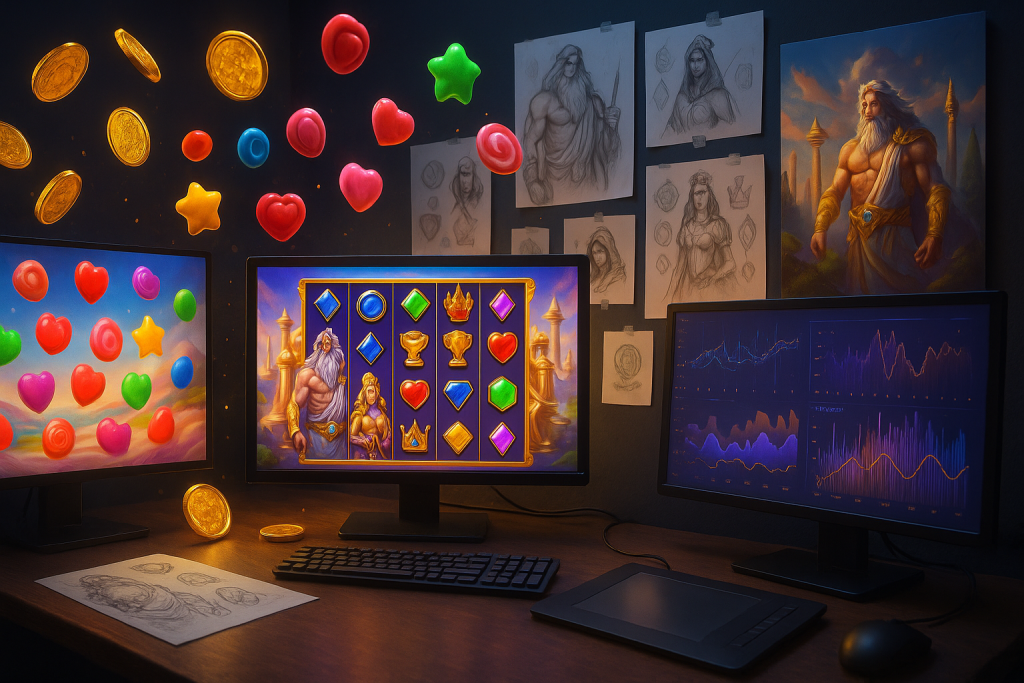There’s something magical about watching those reels spin and landing that perfect combination. But have you ever stopped to wonder what goes into creating a slot game that keeps millions of players coming back? The difference between a forgettable title and a fan favorite isn’t just luck. It’s a carefully orchestrated blend of art, science, and psychology that transforms simple spinning reels into an unforgettable experience.
Let’s pull back the curtain and explore what makes a hit slot game truly special, using real examples from some of the industry’s most beloved titles.
The Foundation: Theme and Visual Identity
Every great slot starts with a compelling theme. Think about Gates of Olympus, one of Pragmatic Play’s most successful releases that has dominated casino lobbies since 2021. The game doesn’t just slap some Greek god imagery on the reels and call it a day. Instead, it transports players to Mount Olympus itself, with Zeus towering over the action and dramatic orchestral soundtracks that make every tumble feel monumental.
The visual design philosophy behind hit slots has evolved significantly. Modern players expect high-definition graphics that work seamlessly across devices. Sweet Bonanza, another Pragmatic Play powerhouse, proves that theme execution matters more than complexity. Its candy-filled world uses bright, eye-catching colors and expert crafting to deliver a visual treat that keeps players engaged.
Game developers spend considerable time on initial sketches, wireframes, and mockups during the conceptual phase. These aren’t just pretty pictures. They’re the blueprint for how symbols, backgrounds, and animations will work together to create an immersive atmosphere. The colorful symbols and dramatic animations in Gates of Olympus demonstrate how visual design can enhance the overall gaming experience, making each win feel genuinely exciting.
The Engine Room: Mechanics That Matter
Here’s where things get technical, but stay with me because this is where the magic really happens. The mechanics underneath those spinning reels determine everything from how often you win to how big those wins can be.
The RTP and Volatility Balance
Return to Player (RTP) and volatility are the twin pillars of slot design. RTP represents the theoretical percentage returned to players over countless spins, while volatility determines the risk-reward profile. Gates of Olympus operates at a generous 96.5% RTP with high volatility, signaling potentially substantial payouts albeit less frequently.
Developers use sophisticated statistical models and random number generators (RNG) to achieve these distributions. The RNG ensures every spin is completely independent and unpredictable, creating fair and transparent results. Before any slot hits the market, it undergoes rigorous testing through simulations to verify the math engine performs exactly as intended.
Innovative Win Mechanics
Traditional paylines have given way to more exciting systems. Gates of Olympus uses a “pay anywhere” mechanic on its 6×5 grid, where landing 8 or more matching symbols anywhere triggers a payout. This innovation, borrowed from cluster-pays systems, dramatically increases win frequency and keeps the action flowing.
Sweet Bonanza pioneered the tumbling reels feature, where winning symbols disappear and new ones cascade down, potentially creating multiple wins from a single spin. This mechanic has become so popular that players now actively seek out slots featuring it. The continuous action keeps engagement high and adds an element of anticipation with each tumble.
Features That Hook Players
The difference between a good slot and a great one often comes down to special features. Successful games layer multiple feature types to create varied gameplay experiences.
Multipliers and Random Events
Zeus’s multiplier feature in Gates of Olympus exemplifies smart feature design. During any spin, multiplier symbols ranging from 2x to a staggering 500x can appear randomly. These get summed up at the end of a tumble sequence and applied to the total win, creating explosive payout opportunities. The randomness keeps players on edge, never quite knowing when Zeus might shower them with divine rewards.
Free Spins and Bonus Rounds
Landing four or more scatter symbols in Gates of Olympus triggers 15 free spins with a game-changing twist. During this bonus round, multiplier symbols add their values to a global multiplier that applies to all subsequent wins. This progressive system can lead to astronomical payouts, with the feature even allowing players to retrigger additional spins.
The Ante Bet feature represents another layer of player choice, letting players increase their stake by 25% to triple their chances of triggering free spins. This optional risk-reward mechanism gives players agency over their experience.
Progressive Jackpots: The Dream Factor
While not every hit slot needs a progressive jackpot, these features add an undeniable thrill factor. Progressive slots pool a percentage of every bet across connected games (sometimes across multiple casinos), creating jackpots that can reach life-changing amounts. The constantly climbing meter displayed prominently on screen attracts players and motivates continued play.
Wide-area progressives like Mega Moolah have created genuine millionaires, proving the appeal of this feature. The jackpot resets to a base amount after someone wins, and the cycle begins anew. Some games trigger jackpots randomly, while others require specific symbol combinations or bonus rounds.
The Psychology of Player Engagement
Here’s the uncomfortable truth: hit slots are designed using principles of behavioral psychology. Understanding this doesn’t diminish the entertainment value, but it does explain why these games are so engaging.
Variable Rewards and Dopamine
Slot games employ variable reward schedules, also called intermittent reinforcement. Players never know when the next win will come or how big it might be. This unpredictability creates dopamine spikes in the brain, linking the spin action with potential rewards despite the inherent randomness.
Even near misses (landing two scatters instead of three) fuel excitement and engagement. The brain processes these almost-wins as meaningful events, encouraging continued play. Sound effects, celebratory music, and animations create a feedback loop that rewards players even for small or non-monetary wins.
Flow State and Immersion
Great slots create a flow state where time and rationality blur. The combination of simple mechanics with high repetition creates effortless engagement. Micro-decisions (like when to buy a bonus feature) add strategic control without overwhelming players. The absence of friction keeps the reels spinning longer.
This intense absorption has been called the “slot-machine zone” by players and researchers alike. While some players use this immersive quality to escape negative thoughts, responsible game design balances engagement with player wellbeing features.
Mobile-First Design Philosophy
Today’s hit slots must work flawlessly on smartphones and tablets. Most slot play now happens on mobile devices, requiring touch-optimized interfaces, lightweight assets, and instant engagement even on slower connections.
Responsive design automatically adapts to various screen sizes, allowing players to switch between devices or rotate between landscape and portrait modes seamlessly. Developers must ensure perfect sizing for touchscreen elements, since small icons frustrate players on mobile devices.
Performance optimization is critical. Games must load quickly, run smoothly without glitches, and maximize battery efficiency. Sticky UI elements keep balance displays, spin buttons, and betting controls easily accessible. Thumb-zone-optimized button placement ensures comfortable one-handed play.
Popular titles like those found on Kwikky and other modern online casino platforms demonstrate this mobile-first approach, with interfaces specifically designed for on-the-go gaming.
Branded Slots: Leveraging Familiar IP
Some of the industry’s biggest hits come from licensed intellectual property. NetEnt’s Jumanji, Blueprint Gaming’s The Goonies, and slots based on popular TV shows like Squid Game prove that familiar entertainment brands attract players, especially newcomers to online casinos.
Branded slots go beyond borrowing a theme. They fully embrace the look, feel, and sound of the originals, often adding unique gameplay features inspired by the source material. This blend of familiar entertainment and interactive gaming creates powerful engagement, though licensing costs mean developers must be confident the brand recognition will drive sufficient player volume.
Testing, Iteration, and Launch
Before any slot reaches players, it undergoes extensive quality assurance. Developers create prototypes (minimum viable products) to test basic mechanics, features, and UI. These lightweight versions help teams understand what works and what needs improvement.
Live RTP performance monitoring ensures games perform as expected in real-world conditions. Developers measure actual RTP against theoretical values, accounting for volatility to determine acceptable tolerance ranges. This ongoing monitoring can detect errors introduced by updates and ensures continued fairness.
The launch phase involves careful marketing to build anticipation. Successful games often debut with promotional campaigns, free spin offers, and featured placement in casino lobbies. The initial reception provides valuable data for potential updates and refinements.
What Makes a Game Stick
Looking at enduring favorites like NetEnt’s Starburst (released way back in 2012 and still topping popularity charts), we see common threads. Simple but engaging mechanics, fair RTPs around 96%, low to medium volatility for frequent wins, and a polished aesthetic that feels timeless rather than trendy.
Starburst’s Win Both Ways technology, where winning combinations can form from left to right or right to left, added meaningful innovation without complexity. Its expanding wild feature triggers free re-spins, creating excitement without overwhelming players. Sometimes the classics endure because they nail the fundamentals.
The Human Element
Behind every hit slot is a team of creative professionals. Artists sketch initial concepts and create final designs. UI/UX designers ensure intuitive interfaces. Developers code the math engines and integrate payment systems. Sound designers craft audio that enhances without overwhelming. QA testers play thousands of spins to catch bugs.
This collaborative process typically spans months from initial concept to launch. The best teams understand they’re not just building gambling software. They’re crafting entertainment experiences that must balance profitability with player satisfaction, excitement with fairness, and innovation with accessibility.
The Takeaway
Creating a hit slot game is far more complex than it appears. It requires understanding player psychology, mastering technical implementation, designing compelling visuals, and balancing dozens of variables from RTP to volatility to feature frequency. Games like Gates of Olympus and Sweet Bonanza succeed because they excel across all these dimensions simultaneously.
The next time you’re spinning the reels, take a moment to appreciate the artistry and science working behind the scenes. Those cascading symbols, dramatic multipliers, and celebratory animations represent countless hours of development, testing, and refinement. The best slots make it all look effortless, and that effortlessness is perhaps the greatest achievement of all.





![‘Jay Kelly’ Review – Noah Baumbach Makes A Case For The Magic Of Movie Stardom [NYFF 2025] ‘Jay Kelly’ Review – Noah Baumbach Makes A Case For The Magic Of Movie Stardom [NYFF 2025]](https://cdn.geekvibesnation.com/wp-media-folder-geek-vibes-nation/wp-content/uploads/2025/11/Jay-Kelly-JKELLY_20240523_15320_C2_R-300x180.jpg)

